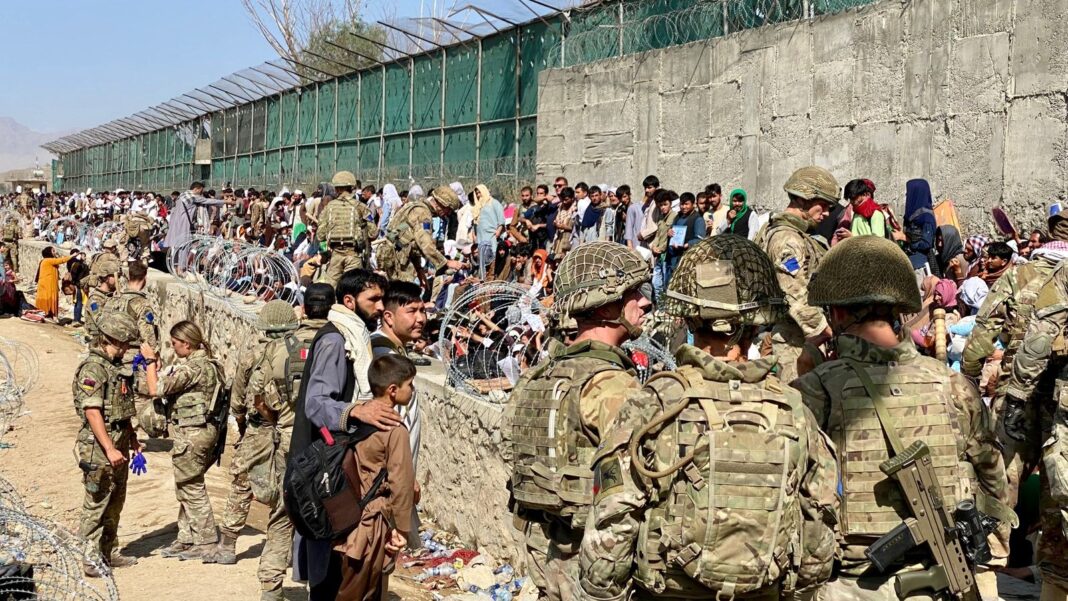Huge crowds of desperate people continued to gather at Kabul airport on Thursday, despite Western governments raising increasing fears about the risk of terrorist attacks.
The United States, Australia, Germany, Britain, and others have warned their citizens against traveling to the airport, as a deadline to end the evacuation of foreigners and Afghans who worked with Western countries for the past two decades closes in.
The US Embassy in Kabul in an updated advisory cited “security threats outside the gates” of the airport, advising citizens to “avoid traveling to the airport and to avoid airport gates at this time unless you receive individual instructions from a US government representative to do so.”
The advisory went on to say that citizens already at the airport’s gates “should leave immediately.”
Britain’s Foreign, Commonwealth and Development Office (FCDO) gave similar advice on Wednesday night.
Denmark said it had completed the evacuation of embassy staff and their families from the Afghan capital. “It is no longer safe to fly from Kabul airport,” Defence Minister Trine Bramsen told Danish news agency Ritzau on Wednesday evening.
The Islamic State affiliate in Afghanistan called Islamic State Khorasan, or ISIS-K, has been singled out as the main threat to the evacuation operation. There are fears the group could exploit the chaos at the airport to target foreign troops and innocent civilians.
The situation has led to chaotic scenes as crowds have been flocking to the airport in the hope of getting a flight out before the August 31 deadline.
What is ISIS-K?
ISIS-K was founded in eastern Afghanistan in 2015. It was originally formed by militants in the Pakistan Taliban but has also seen fighters join from the Afghan Taliban.
The name stands for ‘Islamic State of Khorasan’; Khorasan refers to the central Asian and south Asian region surrounding Afghanistan.
ISIS-K takes a harder line than the Taliban, with a more strict interpretation of Islamic rule.
According to the Centre for Strategic Studies (CSIS), “ISIS-K seeks to establish a Caliphate beginning in South and Central Asia, governed by sharia law, which will expand as Muslims from across the region and world join.”
The Taliban claims to have executed the former leader of ISIS-K, Abu Omar Khorasani, after releasing him from jail along with other terrorist fighters.
ISIS-K has historically recruited those who have split from the Taliban, particularly those believing the group’s rules to be too soft or desiring greater military victories.
The two groups have clashed with other things such as the drug trade, which is used to partly finance militancy. ISIS-K group believes that opium poppy cultivation is un-Islamic.
There are also concerns ISIS-K could try to attack the Afghan capital of Kabul as the evacuation deadline is closed to end.
ISIS-K Operations and Tactics- CSIS study
ISIS-K boasted around 800 fighters in October 2018. It peaked in size in 2016 with up to 4,000 militant members, the Centre for Strategic Studies (CSIS) report shows. These numbers are down from peak levels in 2016 when its fighting force numbered between 3,000 to 4,000 militants, the study noted.
According to the CSIS study, despite the decrease in known fighters, the ISIS-K continues to plot and carry out high-level attacks in Afghanistan and Pakistan and attempts to export its violent ideology to the West. For example, IS-K released congratulatory videos after the 2016 Islamic State inspired attacks in Orlando, Florida, and Magnanville, France, and subsequently released additional footage pleading for further lone-wolf attacks in the West.
Inter-Group Competition in Khorasan
ISIS-K’s expansion sparked violent conflict and rivalry between ISIS-K and some of the region’s existing militant organizations, most notably the Afghan Taliban.
Since January 2017, the study noted that the Armed Conflict Location & Event Data Project (ACLED) has recorded 207 clashes between IS-K and the Afghan Taliban, the CSIS study shows. These clashes occurred in 14 of Afghanistan’s 34 provinces, though the majority took place in Nangarhar, Jowzjan, and Kunar provinces. Clashes in Nangarhar and Kunar are to be expected, as these provinces lay on the border with Pakistan and have served as bases of operation for IS-K since its founding. Violence in Jowzjan, however, largely stems from the defection of former Taliban and IMU commander Qari Hekmatullah, who pledged allegiance to ISIS-K in 2016. Hekmatullah’s networks in Jowzjan facilitated the Islamic State’s expansion in the province through March 2018, but following Hekmatullah’s death by U.S. airstrike in April 2018, the Taliban resurged. In recent months, the Taliban claims to have achieved “exemplary defeat” of ISIS-K in Jowzjan.
United States Response
The U.S. Department of State designated ISIS-K as a Foreign Terrorist Organization on January 14, 2016, and United States Central Command has escalated its air campaign against the group since 2016 when rules of engagement expanded under President Obama and President Trump, CSIS states in the report.
According to data compiled by ACLED, the study noted that the U.S. and NATO airstrikes against ISIS-K have been conducted over 300 times since January 2017. Though the group’s presence across Afghanistan is increasing, airstrikes have been nearly exclusive to Nangarhar and Kunar provinces (96 percent of all airstrikes since January 2017) in an effort to target operational bases and leadership.39 All in all, while ISIS-K’s goal of establishing an Islamic state in Central Asia remains improbable, its propensity for exploiting grievances, catalyzing instability, and taking advantage of ungoverned spaces will make peaceful reconciliation and nation-building in Afghanistan difficult for the foreseeable future.
(Source: The Centre for Strategic Studies and Inputs from agencies)
A global media for the latest news, entertainment, music fashion, and more.





